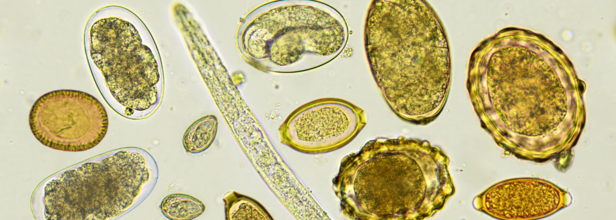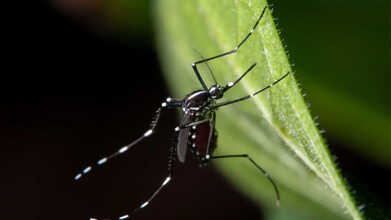- Health Conditions A-Z
- Health & Wellness
- Nutrition
- Fitness
- Health News
- Ayurveda
- Videos
- Medicine A-Z
- Parenting
- Web Stories
10 Signs You May Have A Parasite

Credits: Canva
A parasite is an organism that lives on or in the host organism. It also gets its food from or at the expense of its host. Parasitic infections can be unpleasant as they sound. They are much more common than we think. In fact, in most cases, these infections are the reason behind a lot of health issues that people suffer from. It could be a parasitic infection for all you know that affects your physical, mental, and digestive health.
Types of Parasites
- Roundworms
- Tapeworms
- Pinworms
- Whipworms
- Hookworms
- Lice
- Giardia
- Mosquitos
- Bedbugs
- Scabies
Parasites can come in many shape and sizes. Once inside your body it can make you feel hungry, because it feeds on the nourishment from your body. Whereas there are some that feeds off your red blood cells, and cause you anemia. Since it is all the things we feel from within, many times, people do not even realise that they are suffering from a parasitic infection and that it could lad to chronic health problems. It is also important to look out for causes, signs, and symptoms that indicate a parasitic infection to start treatment as soon as possible.
How Can You Get Intestinal Parasites?
- If you live in or visit an area which is known to have parasites
- During an international travel
- If you consume contaminated or unclean food or water
- If you eat uncooked meats
- If you maintain a poor hygiene
- If you have a weakened immune system or HIV or AIDS
- If you work closely with animals, or handle soil or other waste material
Once you are infected with a parasite, it is easy to pass it along to others. If you have a parasite and you do not wash your hands after using the restroom, you can easily pass microscopic parasite eggs onto anything that you touch. It could also come from the common places like the bathroom door handle, a salt shaker, your phone, or just anything that you touch.
How Would You Know If You Have A Parasite?
Here are 10 signs that will help you identify if you have a parasitic infection in your body.
1. Digestive Issues
Unexplained constipation, diarrhea, gas, bloating, heartburn, or nausea could signal a parasitic infection. Intestinal parasites settle in the gastrointestinal (GI) tract, triggering immune responses that cause a range of symptoms. Many of these are often mistaken for Irritable Bowel Syndrome (IBS). Unfortunately, routine lab tests may not always detect parasites, and more sensitive diagnostics like the GI-MAP test are needed for accurate identification.
2. Chronic Fatigue & Exhaustion
Parasites can drain your body's nutrients, leading to persistent fatigue, mood changes, headaches, and even memory issues. Some, like Giardia, can cause chronic fatigue syndrome, making it difficult for your body to absorb essential nutrients like iron and B12. This deficiency results in unexplained lethargy, which can disrupt daily life.
3. Skin Problems
Mysterious rashes, hives, eczema, or rosacea may be linked to parasites. When parasites trigger an immune response, your body produces more Immunoglobulin E (IgE) antibodies, leading to allergic reactions that manifest as stubborn skin issues. If over-the-counter treatments aren’t helping, a parasitic infection might be the hidden cause.
4. Muscle & Joint Pain
Some parasites release inflammatory toxins that can settle in muscles and joints, causing pain and stiffness. A specific parasite, Trichinella, found in undercooked meat, can migrate to muscles, leading to persistent aches that don’t respond to usual treatments.
5. Anemia
Certain parasites consume red blood cells or cause internal bleeding, resulting in iron deficiency anemia. This leads to fatigue, weakness, and pale skin, as your body struggles to function with reduced oxygen levels.
6. Constant Hunger or Loss of Appetite
Feeling hungry all the time, despite eating regularly, could indicate a tapeworm or other parasite feeding off your nutrients. On the other hand, nausea and gas can suppress appetite, causing unintentional weight loss.
7. Itching
Some parasites burrow under the skin or lay eggs, leading to intense itching. Pinworms, for example, cause persistent itching around the anus, especially at night. The immune system's response to parasites can also trigger allergic reactions, worsening the irritation.
8. Teeth Grinding (Bruxism)
Grinding your teeth at night could be linked to toxins released by parasites. These toxins interfere with neurotransmitters, triggering anxiety, nervousness, and involuntary teeth grinding while sleeping.
9. Insomnia & Sleep Disturbances
Parasites are often more active at night, causing physical discomfort and disrupting sleep. If you're experiencing frequent wake-ups or unexplained restlessness, an underlying parasitic infection might be the reason.
10. Bloating & Gas
Parasites like Giardia can lead to excessive gas and bloating, making your stomach feel constantly distended. The severity of symptoms varies, and while some people experience major discomfort, others may have a parasitic infection without any noticeable symptoms.
LA County Detects First Human West Nile Case; Know Safety And Precaution Tips

Credits: Canva
West Nile Cases in the US: The United States seems to be facing a fresh health challenge this season. After a rise in COVID-19 cases, Los Angeles County has now confirmed its first human infections of West Nile virus for 2025.
According to LA County Department of Public Health officials, four residents have been hospitalised with the mosquito-borne illness between late July and late August. The patients are from the Antelope Valley, San Fernando Valley, and central Los Angeles, and all are currently recovering.
With West Nile virus once again making its presence felt, it is important to understand the disease and the precautionary steps that can help lower the risk of infection.
West Nile Virus: How the Virus Is Spreading In The US
West Nile virus continues to be the most widespread mosquito-borne illness in the continental United States. The World Health Organization warns that while most infections are mild or even unnoticed, the virus can, in rare cases, lead to fatal neurological disease.
Roughly 80% of people who contract West Nile show no symptoms at all. Transmission occurs primarily through the bite of infected mosquitoes. The first confirmed cases of the 2025 season were reported this week by the Los Angeles County Department of Public Health.
ALSO READ: West Nile Virus Isn't Over Yet, New Cases In US On Rise
“The first human cases of West Nile virus are an important reminder that we all need to take steps to prevent mosquito bites and mosquito breeding,” said Dr Muntu Davis, Los Angeles County Health Officer. He added that mosquitoes flourish in hot weather, which raises the risk of both bites and mosquito-borne illness.
West Nile virus is usually detected in LA County during the summer months, when warm overnight temperatures help mosquito populations thrive. On average, the county records about 56 human cases each year. Officials believe the real number is much higher, since most infections either cause no illness or only mild symptoms. Of those reported, however, three-quarters are considered severe, and about 10% of those cases result in death from complications.
What Are the First Signs of West Nile Virus?
Most people infected with West Nile virus never develop symptoms, about 80% remain asymptomatic. For the remaining 20%, the illness typically appears as West Nile fever, which includes flu-like signs such as fever, headache, fatigue, body aches, nausea, vomiting, and sometimes a rash on the trunk or swollen lymph nodes, according to the World Health Organization.
In rare cases, the infection can progress to a severe neuroinvasive disease such as encephalitis, meningitis, or poliomyelitis. Symptoms of this form include high fever, severe headache, neck stiffness, confusion, stupor, tremors, seizures, muscle weakness, paralysis, and in extreme cases, coma. Around 1 in 150 infected individuals develop such severe illness.
ALSO READ: West Nile Virus Spotted In Weld County Mosquitoes, Here’s What You Need To Know
Although serious disease can occur at any age, people over 50 and those with weakened immune systems such as transplant recipients face the highest risk of complications. The incubation period for West Nile virus usually ranges from 3 to 14 days after a mosquito bite.
West Nile Virus Treatment: Do We Have a Vaccine Yet?
There is currently no specific treatment or vaccine for West Nile virus in humans. Care is supportive, especially for patients with neuroinvasive disease. Severe cases may require hospitalization, intravenous fluids, respiratory support, and measures to prevent secondary infections.
West Nile Virus Precaution Tips
Since no licensed vaccine or medication exists to prevent West Nile virus, the most effective protection is avoiding mosquito bites. The U.S. Centers for Disease Control and Prevention recommends the following steps:
- Use insect repellent that is registered with the Environmental Protection Agency.
- Wear long, loose-fitting clothing to reduce exposed skin.
- Limit outdoor activity between dusk and dawn, when the mosquitoes that carry West Nile virus are most active.
- Keep mosquitoes out by using window and door screens or air conditioning where possible.
Prevention is always better than cure, and the simplest way to stay protected from West Nile virus is by keeping mosquitoes at bay.
Selena Gomez Reveals Battling Finger Arthritis Caused By Lupus; Know How Lupus Affects Your Joints

Credits: Canva
Global pop star Selena Gomez has opened up about developing arthritis as a consequence of lupus. The singer, who has long been candid about her health challenges, was first diagnosed with lupus in 2013 and later underwent a kidney transplant.
In a recent conversation with Amy Poehler on her podcast ‘Good Hang with Amy Poehler,’ Gomez discussed her Rare Beauty brand, including its easy-to-use packaging, and shared how her personal health experiences influenced these choices. “I have arthritis in my fingers because of my lupus,” she said. “Before I started the right treatment, even simple things like opening a water bottle were really painful.”
What Is Lupus?
Lupus is an autoimmune condition that causes inflammation throughout the body. In this disease, the immune system mistakenly attacks healthy tissues instead of protecting them. Depending on which tissues are affected, lupus can impact the skin, blood, joints, kidneys, brain, heart, or lungs.
ALSO READ: Can Leg Workouts Help Protect Your Brain From Ageing? Expert Weighs In
Medically known as systemic lupus erythematosus (SLE), lupus can affect anyone, though it is far more common in women, particularly those between 15 and 45 years of age. Symptoms vary widely and may include joint pain, fatigue, rashes, and even complications involving internal organs. The disease is unpredictable—it can remain quiet for months and then flare up suddenly, often without warning.
For Selena Gomez, lupus has been more than a medical diagnosis; it has profoundly influenced her life. She first publicly shared her lupus diagnosis in 2015, explaining how she had to pause her career to focus on treatment.
How Does Lupus Trigger Arthritis?
On a recent episode of Good Hang with Amy Poehler, Selena Gomez revealed that lupus caused arthritis in her fingers. Unlike osteoarthritis, which results from joint wear and tear, lupus-related arthritis stems from immune system dysfunction. When the immune system attacks its own tissues, it can lead to:
- Inflammation and swelling in the joints, particularly in the hands, wrists, and knees
- Painful stiffness, often worse in the morning
- Flare-ups that make even simple tasks, like opening a water bottle, difficult
- Painless mouth sores
- Skin rashes, including the classic butterfly-shaped rash across the cheeks and nose
- Fatigue and unexplained fevers
- Chest pain or difficulty breathing
- Headaches, dizziness, brain fog, or confusion
- Sensitivity to light and hair loss
Early Signs of Lupus in Females
Lupus predominantly affects women, with about nine out of ten cases occurring in females. Early recognition is key to timely diagnosis and effective management. Common early signs include:
- Persistent fatigue
- Joint pain or swelling, especially in hands, wrists, and knees
- Skin rashes, particularly the butterfly-shaped rash across the cheeks and nose
- Hair thinning or hair loss
- Mouth sores
- Sensitivity to sunlight
- Raynaud’s phenomenon, where fingers and toes turn white or blue in response to cold or stress
Managing LupusCurrently, there is no cure for lupus. Treatment focuses on managing symptoms and reducing flare-ups, with the goal of putting the disease into remission, which means long periods without symptoms.
Silent Heart Attack Could Look Like Every Day Aches: Cardiologist Reveals Signs You Shouldn’t Ignore

A 59-year-old woman came in for a follow-up visit for her shingles. During her appointment, she mentioned a small detail: she'd been feeling some skipped heartbeats, and her heart rate was a bit jumpy.
The woman had some preexisting health issues like being overweight, high blood pressure, high cholesterol, and prediabetes. Her comment about the jumpy heartbeat caught the attention of the doctor.
These small complaints led her doctor to do a more detailed check-up. An EKG, a test that checks the heart's electrical activity, revealed some key signs. The results showed that she had already suffered a heart attack, even though she hadn't felt it.
This was a 2023 case study published in the Cureus, doctors call this a "silent heart attack," or silent myocardial infarction (SMI). Unlike a typical heart attack, a silent one has no symptoms or only very mild ones, so people don't realize what's happening and don't get medical help. These cases are often discovered by chance during a routine check-up.
While you may not have heard of such cases before, they are not as uncommon as you may think they are. According to American Heart Association, of the estimated 805,000 heart attacks each year in US, 170,000 of them are silent heart attacks.
As the name suggests, these attacks are difficult to recognize but not impossible. We spoke to consultant interventional cardiologists Pankaj Vinod Jariwala of Yashoda Hospitals and Dr. P Praveen Kumar of Karpagam Hospital Dr. Krunal Tamakuwala KD Hospital, to understand more about it.
Who Is At Risk for Silent Heart Attacks?
Silent heart attacks are becoming more common, and they aren't just affecting older men. Doctors are now seeing them in people as young as their late 30s and early 40s, especially those with high-stress jobs. Dr Jariwala said, “They mistake early signs for lifestyle issues: acidity after a heavy dinner, shoulder pain from sitting at a laptop, or tiredness from long hours.”
As Dr. Krunal Tamakuwala points out, the real danger is not that these heart attacks are completely "symptomless," but that their symptoms are so common that they are easily ignored. By the time a person finally sees a doctor, their heart may already be seriously damaged. “Sometimes, it arrives silently, hidden behind complaints we consider minor. That is why doctors urge patients not to ignore symptoms that linger or feel unusual, even if they seem harmless at first.” explained Dr Tamakuwala
What Are The Symptoms Of Silent Heart Attacks?
Many people mistake the early signs of a silent heart attack for everyday issues. Symptoms like
- Acidity
- Shoulder pain
- Tiredness
These are often brushed off as normal problems from a busy lifestyle. In places like India, people tend to make the problem worse by self-medicating with antacids or painkillers, which only delays getting proper medical help.
The reason these heart attacks are so confusing is due to something called referred pain. According to Dr. P Praveen Kumar, the nerves that carry pain signals from the heart are the same ones that connect to the stomach, back, and shoulders. This means that a problem with your heart can cause discomfort in another part of your body.
For people with diabetes, the situation is even more complicated. They may not feel the classic chest pain at all because their nerve sensitivity is reduced. For them, a silent heart attack might feel like
- Simple bloating
- Indigestion
- A dull backache.
The key is to remember that not all heart attacks announce themselves with a dramatic crushing pain. Dr Praveen warns, “f these symptoms are joined by sweating, breathlessness, or dizziness, you should seek medical help immediately.”
Doctors emphasize that lifestyle choices are key to keeping your heart healthy. Regular exercise, a balanced diet, quitting smoking, and managing stress are no longer optional, especially in countries like India, where heart disease is affecting younger people. “Everyday aches may feel ordinary, but when it comes to the heart, they could be the difference between early intervention and irreversible damage.”
© 2024 Bennett, Coleman & Company Limited

